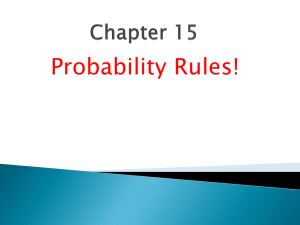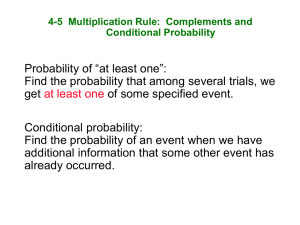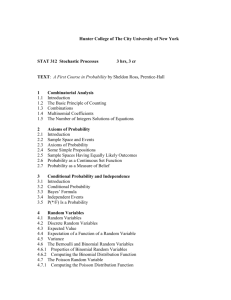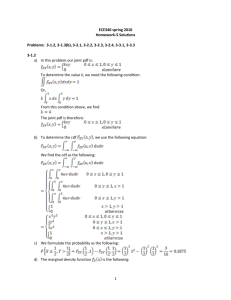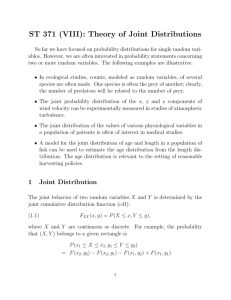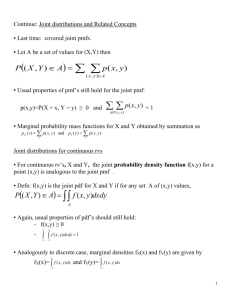Notes 18
advertisement
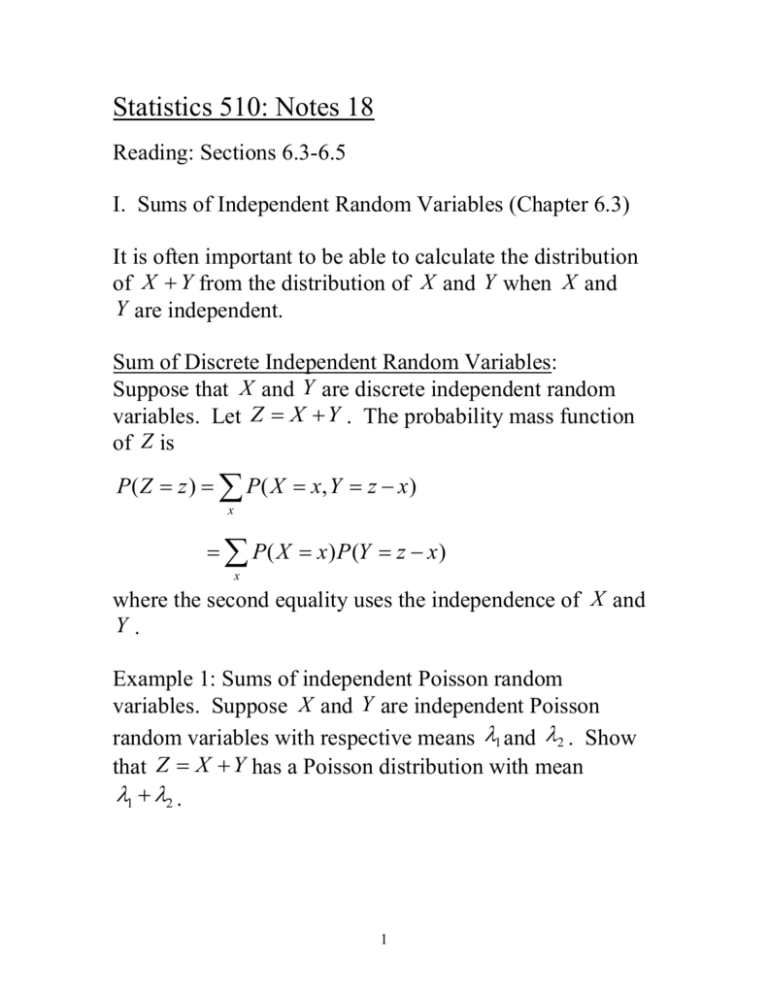
Statistics 510: Notes 18
Reading: Sections 6.3-6.5
I. Sums of Independent Random Variables (Chapter 6.3)
It is often important to be able to calculate the distribution
of X Y from the distribution of X and Y when X and
Y are independent.
Sum of Discrete Independent Random Variables:
Suppose that X and Y are discrete independent random
variables. Let Z X Y . The probability mass function
of Z is
P ( Z z ) P ( X x, Y z x )
x
P ( X x ) P (Y z x )
x
where the second equality uses the independence of X and
Y.
Example 1: Sums of independent Poisson random
variables. Suppose X and Y are independent Poisson
random variables with respective means 1 and 2 . Show
that Z X Y has a Poisson distribution with mean
1 2 .
1
Sums of Continuous Independent Random Variables:
Suppose that X and Y are continuous independent random
variables. Let Z X Y . The CDF of Z is
FZ (a ) P ( Z a )
P( X Y a)
f XY ( x, y )dxdy
x y a
2
f X ( x) fY ( y )dxdy (using X , Y independent)
x ya
a y
F
a y
X
f X ( x) fY ( y )dxdy
f X ( x)dxfY ( y )dy
(a y ) fY ( y )dy
By differentiating the cdf, we obtain the pdf of Z X Y :
d
f Z (a)
FX (a y ) fY ( y )dy
da
d
F (a y ) fY ( y )dy
da X
f X (a y ) fY ( y )dy
Example 2: Sum of independent uniform random variables.
If X and Y are two independent random variables, both
uniformly distributed on (0,1), calculate the pdf of
Z X Y .
3
Sum of independent normal random variables:
Proposition 6.3.2: If X i , i 1, , n, are independent
random variables that are normally distributed with
2
respective means and variances i , i , i 1, , n, then
n
X
i 1
n
i
is normally distributed with mean
2
i
.
i 1
i
and variance
n
i 1
The book contains a proof of Proposition 6.3.2 that
calculates the distribution of X 1 X 2 using the formula for
the sum of two independent random variables established
above, and then applying induction. We will prove
Proposition 6.3.2 in Chapter 7.7 using Moment Generating
Functions.
4
Example 3: A club basketball team will play a 44-game
season. Twenty-six of these games are against class A
teams and 18 are against class B teams. Suppose that the
team will win each against a class A team with probability
.4 and will win each game against a class B team with
probability .7. Assume also that the results of the different
games are independent. Approximate the probability that
the team will win 25 games or more.
5
II. Conditional Distributions (Chapters 6.4-6.5)
(1) The Discrete Case:
Suppose X and Y are discrete random variables. The
conditional probability mass function of X given Y y j is
the conditional probability distribution of X given Y y j .
The conditional probability mass function of X|Y is
p X |Y ( xi | y j ) P( X xi | Y y j )
P( X xi , Y y j )
P(Y y j )
p X ,Y ( xi , y j )
pY ( y j )
(this assumes P (Y y j ) 0 ). This is just the conditional
probability of the event X xi given that Y y j .
If X and Y are independent random variables, then the
conditional probability mass function is the same as the
unconditional one. This follows because if X is
independent of Y, then
p X |Y ( x | y ) P ( X x | Y y )
P ( X x, Y y )
P (Y y )
P ( X x) P (Y y )
P (Y y )
P( X x)
6
Example 3: In Notes 17, we considered the situation that a
fair coin is tossed three times independently. Let X denote
the number of heads on the first toss and Y denote the total
number of heads.
The joint pmf is given in the following table:
Y
X
0
1
2
3
0
1/8
2/8
1/8
0
1
0
1/8
2/8
1/8
What is the conditional probability mass function of X
given Y? Are X and Y independent?
(2) Continuous Case
If X and Y have a joint probability density function
f ( x, y ) , then the conditional pdf of X, given that Y=y , is
defined for all values of y such that fY ( y) 0 , by
7
f X |Y ( x | y)
f X ,Y ( x, y)
fY ( y ) .
To motivate this definition, multiply the left-hand side by
dx and the right hand side by (dxdy ) / dy to obtain
f X ,Y ( x, y )dxdy
f X |Y ( x | y )dx
fY ( y )dy
P{x X x dx, y Y y dy}
P{ y Y y dy}
P{x X x dx | y Y y dy}
In other words, for small values of dx and dy ,
f X |Y ( x | y ) represents the conditional probability that X is
between x and x dx given that Y is between y and y dy .
The use of conditional densities allows us to define
conditional probabilities of events associated with one
random variable when we are given the value of a second
random variable. That is, if X and Y are jointly continuous,
then for any set A,
P{X A | Y y} f X |Y ( x | y)dx .
A
In particular, by letting A (, a] , we can define the
conditional cdf of X given that Y y by
a
FX |Y (a | y) P( X a | Y y) f X |Y ( x | y)dx .
8
Example 4: Suppose X and Y are two independent random
variables, both uniformly distributed on (0,1). Let
T1 min{ X , Y }, T2 max{ X , Y } . What is the conditional
distribution of T2 given that T1 t ? Are T1 and
T2 independent?
9
10


